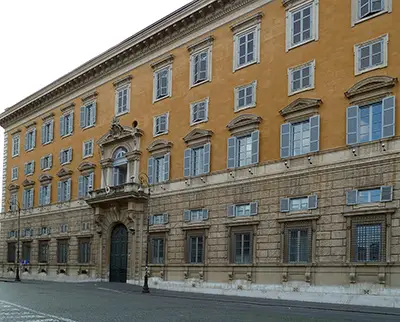Vatican City is actually a sovereign state while the Holy Sea comes under the jurisdiction of the Bishop of Rome. Nevertheless, Vatican City claims ownership of the Palace which lies on Italian soil.
It is home to the Congregation for the Doctrine of Faith.
The Palace of the Holy Office was built after 1514 under the aegis of Cardinal Lorenzo Pucci. They conveniently named it Palazzo Pucci to reflect its owner. In 1524, architects Pietro Roselli, Giuliano Leni and Michelangelo rebuilt the façade. Cardinal Pucci eventually died, but the Palace was far from being complete.
Between 1566 and 1567, Pope Pius IV came onto the scene and purchased the Palace at the cost of 9,000 scudi. The Pope then converted it into the seat of the Holy Office, necessitating renovations.
Pirro Ligorio and Giovanni Sallustio Peruzzi were on hand to carry out the refurbishment. However, it took the effort of another architect, Pietro Guidi to perform complete renovations to the building. These repairs lasted for five years.
Joseph Cardinal Ratzinger, now Pope Benedict, worked here as Prefect of the Congregation.
Location
The Palace of the Holy Office is located south of St Peter’s Basilica next to the Petriano Entrance to the Vatican City.
Being located outside the boundaries of the Vatican City, it enjoys extraterritorial status because it is regulated by the Holy See, having signed a treaty in 1929 with the Kingdom of Italy.
Current Tenants
The Palace is currently occupied by the Congregation for the Doctrine of Faith, a body responsible for the preservation and promulgation of the Catholic doctrine. Initially known as the Supreme Sacred Congregation of the Roman and Universal Inquisition, it is now referred to as the Holy Office by many Catholic countries. The period from 1908 to 1965 saw another change of name to the Supreme Sacred Congregation of the Holy Office.
It is the earliest of the nine congregations that mark the Roman Curia. Its primary purpose is to shield the Catholic Church from heresy. Pope John Paul founded the Congregation in 1542 with the sole aim of spreading sound Catholic doctrines and protecting Christian principles that were in danger of being vanquished by new edicts.
Operating from inside the Palace of the Holy Office, the Congregation employs an advisory board that comprises of cardinals, priests, bishops and theologians. It also includes Canon lawyers for legal matters and representation. The current prefect is Cardinal Gerhard Ludwig Muller.
The Michelangelo Effect
It is no doubt that Michelangelo's role in the architecture of the Palace left an indelible mark on the history of Catholic buildings. Together with Roselli and Leni, Michelangelo helped set the stage for the construction of a timeless piece of architecture. The facade, though renovated, still reflects Michelangelo’s art.
Consequently, the Palace of the Holy Office has stood the test of time and is one of those few buildings that have the extraterritorial tag. This was due to its location just outside the Vatican City but still close enough to be part of the Vatican. The arched and recessed doorways and windows show magnificence that only Michelangelo was capable of achieving.
The Palace of the Holy Office is one of the many impressive architectural works by Michelangelo. Even after undergoing massive renovations, it still stands out as a timeless piece of art. The building has become significant to the Catholic Church because it is now owned by the Holy Sea. It is in this building that doctrine is researched and made as a way of preserving the Catholic faith. Michelangelo’s contributions cannot be gainsaid.


